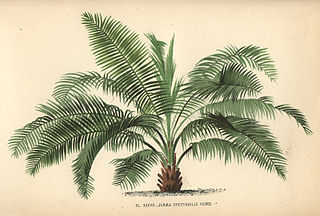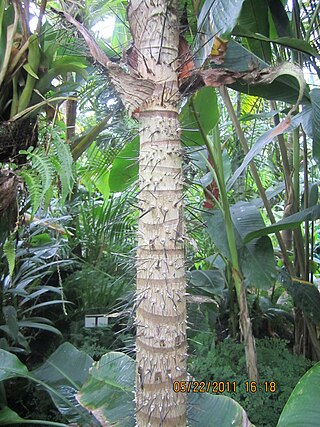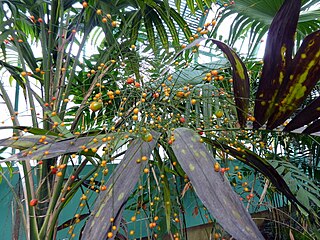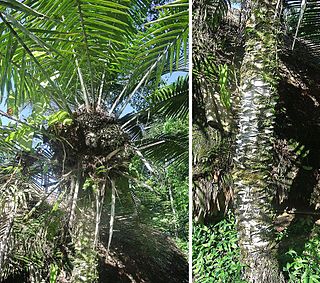
Corypheae is a tribe of palm trees in the subfamily Coryphoideae. In previous classifications, tribe Corypheae included four subtribes: Coryphinae, Livistoninae, Thrinacinae and Sabalinae, but recent phylogenetic studies have led to the genera within these subtribes being transferred into other tribes. Tribe Corypheae is now restricted to the genus Corypha alone.

Cryosophileae is a tribe of palms in the subfamily Coryphoideae. The tribe ranges from southern South America, through Central America, into Mexico and the Caribbean. It includes New World genera formerly included in the tribe Thrinacinae, which was split after molecular phylogenetic studies showed that Old World and New World members of the tribe were not closely related.

Cocoseae is a tribe of cocosoid palms of the family Arecaceae.
Areceae is a palm tree tribe in the family Arecaceae.

Caryoteae is a tribe in the palm family Arecaceae, distributed across Southeast Asia, from southern India and Sri Lanka east to Vanuatu and northernmost Queensland, Australia. It was long considered a member of subfamily Arecoideae on the basis of its inflorescences, which resemble those of tribe Iriarteeae, and the flowers arranged in triads, which are common across Arecoideae. However, phylogenetic studies based on DNA repeatedly link Caryoteae to subfamily Coryphoideae. Caryoteae do have leaves with induplicate folds, a feature found in most Coryphoid palms, but unlike most Coryphoideae, the leaves are pinnate or bipinnate (Caryota). Phoenix is the only other Coryphoid genus with induplicate, pinnate leaves.

Iriarteeae is a palm tribe in the subfamily Arecoideae.

Chamaedoreeae is a palm tribe in the subfamily Arecoideae. It has five genera.

Chuniophoeniceae is a tribe of palms in subfamily Coryphoideae of plant family Arecaceae. The four genera within the tribe are morphologically dissimilar and do not have overlapping distributions. Three of the genera are monotypic, while the fourth genus (Chuniophoenix) has three species.

Trachycarpeae is a tribe of palms in subfamily Coryphoideae of the plant family Arecaceae. It has the widest distribution of any tribe in Coryphoideae and is found on all continents, though the greatest concentration of species is in Southeast Asia. Trachycarpeae includes palms from both tropical and subtropical zones; the northernmost naturally-occurring palm is a member of this tribe. Several genera can be found in cultivation in temperate areas, for example species of Trachycarpus, Chamaerops, Rhapidophyllum and Washingtonia.

Phytelepheae is a tribe of plants in the subfamily Ceroxyloideae of the family Arecaceae.
Lepidocaryeae is a tribe of plants in the family Arecaceae. Subtribes and genera in the tribe are:
Ceroxyleae is a tribe of plants in the family Arecaceae. Genera in the tribe are:

Geonomateae is a palm tribe in the subfamily Arecoideae. It is an important Neotropical group due to its wide distribution across Central and South America, its diversity and abundance, and the use of a number of species by local human populations. The distribution of the tribe stretches from southeast Mexico down through Central America and into South America, notably Brazil and Bolivia, and species are also found in the Greater and Lesser Antilles. This tribe consists of a group of understory and sub-canopy palms that populate both tropical lowland and montane forests. While members of this group are relatively easy to collect, as they are not canopy palms or spiny palms, and are well represented in herbaria, the taxonomy and phylogeny of the species within the tribe are still uncertain. The resolution of the tribe has been disputed despite the fact that tribe's species are characterized by three morphological synapomorphies: the petals of pistillate flowers are basally connate, the presence of slender and elongate styles, and the flowers are borne in pits in the rachillae.
Pelagodoxeae is a tribe of plants in the family Arecaceae found in Oceania, namely in New Guinea and the Marquesas Islands. The tribe has two monotypic genera, which are:
Mauritiinae is a subtribe of plants in the family Arecaceae found in northern South America. Genera in the subtribe are:
Attaleinae is a subtribe of plants in the family Arecaceae. Genera in the subtribe, the majority of which are found in South America, are:
Bactridinae is a subtribe of plants in the family Arecaceae found in the New World. Genera in the subtribe are:
Elaeidinae is a subtribe of plants in the family Arecaceae found in tropical South America and Africa. Genera in the subtribe are:
Genera Palmarum is a botany reference book that gives a detailed overview of the systematic biology of the palm family (Arecaceae). The first edition of Genera Palmarum was published in 1987. The second edition was published in 2008, with a reprint published in 2014. Genera Palmarum is currently the most detailed monograph on palm taxonomy and systematics.











